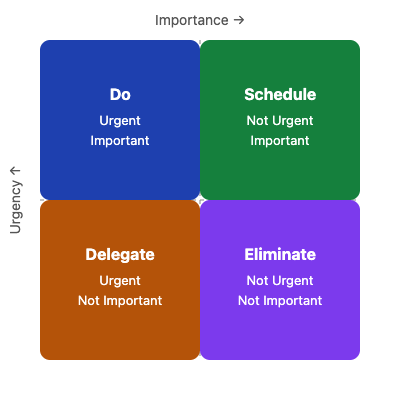Ambiguity is a fact of life in project management, but your ability to move forward confidently is what sets you apart. When requirements are unclear or priorities keep shifting, your job is to keep the team focused, make decisions with the information you have, and adapt as things change. Navigating ambiguity isn’t about having all the answers — it’s about acting decisively, communicating clearly, and keeping momentum.
You’ll often find yourself in situations like:
- Sorting through a pile of urgent requests and vague requirements, trying to figure out what matters most
- Making decisions when you don’t have all the data you want
- Re-aligning the team when stakeholders change direction or new information comes in
Let’s break down how to handle these moments with confidence.
When everything feels urgent and the details are fuzzy, focus on what will have the biggest impact. Tools like the Eisenhower Matrix can help you quickly sort tasks by urgency and importance.

For example:
- If a client request is high-impact but missing details, treat it as “Important but Not Urgent” and keep it on your radar, while you tackle “Important and Urgent” items like a critical bug fix.
- Ask yourself: What absolutely must move forward today? What can wait? What can I delegate or drop?
This approach helps you act decisively, even when the full picture isn’t available.
You won’t always have every answer before a deadline. Strong project managers keep things moving by weighing risks and trade-offs, using the best information at hand.
Use the table below to guide your approach to common ambiguous situations and how to communicate your decisions to the team:
Navigating constant change is a core part of project management. In fast-moving projects, priorities can shift overnight as clients refine their goals, stakeholders introduce new requirements, or unexpected challenges arise. Being able to quickly reassess, adapt, and guide your team through these changes is a core skill for keeping projects on track.
Your role is to:
- Reassess what matters most
- Communicate changes clearly
- Help your team refocus and stay aligned
Here’s how adaptability might sound in a real conversation:
- Jessica: Chris, the client just changed their priorities—they now want the API integration finished before the dashboard redesign. How should we handle this?
- Chris: Let’s pause work on the dashboard and shift our focus to the API integration. I’ll update the team and make sure everyone knows the new priorities.
- Jessica: Should we let the client know about the change in our timeline?
- Chris: Absolutely. I’ll communicate the updated plan and any impacts to the schedule so they’re in the loop.
- Jessica: Got it. I’ll coordinate with the team and make sure we’re all aligned on the new direction.
In this exchange, Jessica and Chris demonstrate adaptability by quickly reassessing priorities, communicating changes clearly, and keeping both the team and client informed.
By building these skills, you’ll foster trust and resilience within your team, helping everyone stay focused and effective. Next, you’ll have the chance to put these strategies into action in a role-play scenario, where you’ll practice adjusting priorities and communicating changes as new information emerges.
